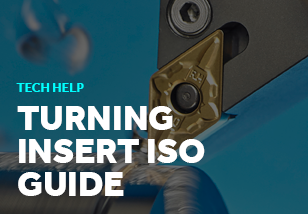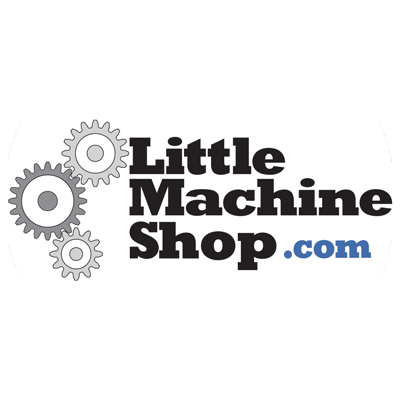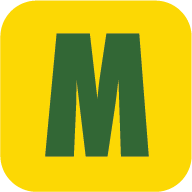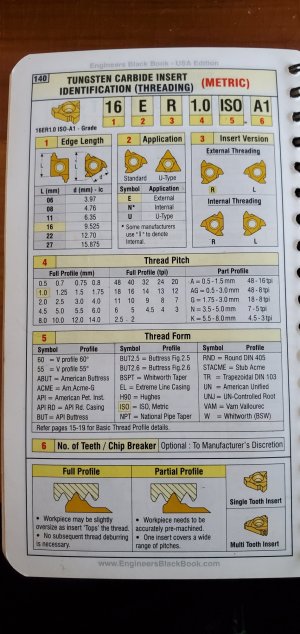-
Scam Alert. Members are reminded to NOT send money to buy anything. Don't buy things remote and have it shipped - go get it yourself, pay in person, and take your equipment with you. Scammers have burned people on this forum. Urgency, secrecy, excuses, selling for friend, newish members, FUD, are RED FLAGS. A video conference call is not adequate assurance. Face to face interactions are required. Please report suspicions to the forum admins. Stay Safe - anyone can get scammed.
You are using an out of date browser. It may not display this or other websites correctly.
You should upgrade or use an alternative browser.
You should upgrade or use an alternative browser.
Tips/Techniques Carbide Turning Inserts - Tutorial
- Thread starter Ironman
- Start date
Tips/Techniques
You're such a tease
Where?
The cynic in me thinks that is Ironman's point. LMAO!
What is out there is all Greek!
Most of the insert makers have charts. Some even have both ISO and ansi.
In desperation, I bought and liked "Introduction to Indexable Tooling" by David Best. It's not very detailed and prolly useless for the carbide wizards on here, but it taught me enough that I feel comfy reading the manufacturers charts and data now. I just wish my memory was better.
In desperation, I bought and liked "Introduction to Indexable Tooling" by David Best. It's not very detailed and prolly useless for the carbide wizards on here, but it taught me enough that I feel comfy reading the manufacturers charts and data now. I just wish my memory was better.
It's good. Much faster learning curve. But falls apart for imperial designations.
One of biggest confusions for me was which one it uses.
Imperial typically only has 3 numbers instead of 6 after the 4 letters. I say typically because sometimes it has more. It can even have a decimal. It sucks but it's common.
I've found its 50/50 whether it's ISO or ANSI.
One of biggest confusions for me was which one it uses.
Imperial typically only has 3 numbers instead of 6 after the 4 letters. I say typically because sometimes it has more. It can even have a decimal. It sucks but it's common.
I've found its 50/50 whether it's ISO or ANSI.
As a newbie I found this intro to cutting tool shapes by Blondihacks very useful:
Old Tony mostly on Carbide inserts:
On the same topic but only ISO:

 www.cutwel.co.uk
www.cutwel.co.uk
Both from LMS:

 littlemachineshop.com
littlemachineshop.com
ANSI only:

 littlemachineshop.com
littlemachineshop.com
Indexable boring bars:

 littlemachineshop.com
littlemachineshop.com
If you're not confused yet - and have some money to spare:
 www.sandvik.coromant.com
www.sandvik.coromant.com
A Swiss take:
 store.denitool.com
store.denitool.com
Kennametal:
 www.kennametal.com
www.kennametal.com
McMaster:

 www.mcmaster.com
www.mcmaster.com
Old Tony mostly on Carbide inserts:
On the same topic but only ISO:

Understanding the ISO Code System for Turning Inserts: A Comprehensive Guide
Understanding the ISO Code System for Turning Inserts: A Comprehensive Guide
Both from LMS:

ANSI and ISO Insert Designations
These charts show the ANSI and ISO designations for turning indexable inserts.
ANSI only:

ANSI Turning Tool Designations
This table shows the ANSI designations for indexable tool holders for external turning.
Indexable boring bars:

ANSI Boring Bar Designations
This table shows the ANSI designations for indexable boring bars for internal turning.
If you're not confused yet - and have some money to spare:
Sandvik Coromant
A Swiss take:
Indexable Insert – Denitool
Kennametal:
Selecting Carbide Inserts for Metalworking | Kennametal
Indexable turning, milling, and drilling tools are often the best choice for productive, cost-effective machining. Learn more about carbide inserts, and how to buy the right carbide inserts online.
McMaster:
McMaster-Carr
McMaster-Carr is the complete source for your plant with over 595,000 products. 98% of products ordered ship from stock and deliver same or next day.
As a newbie I found
Thanks so much for all the research and all those links Manfred!

